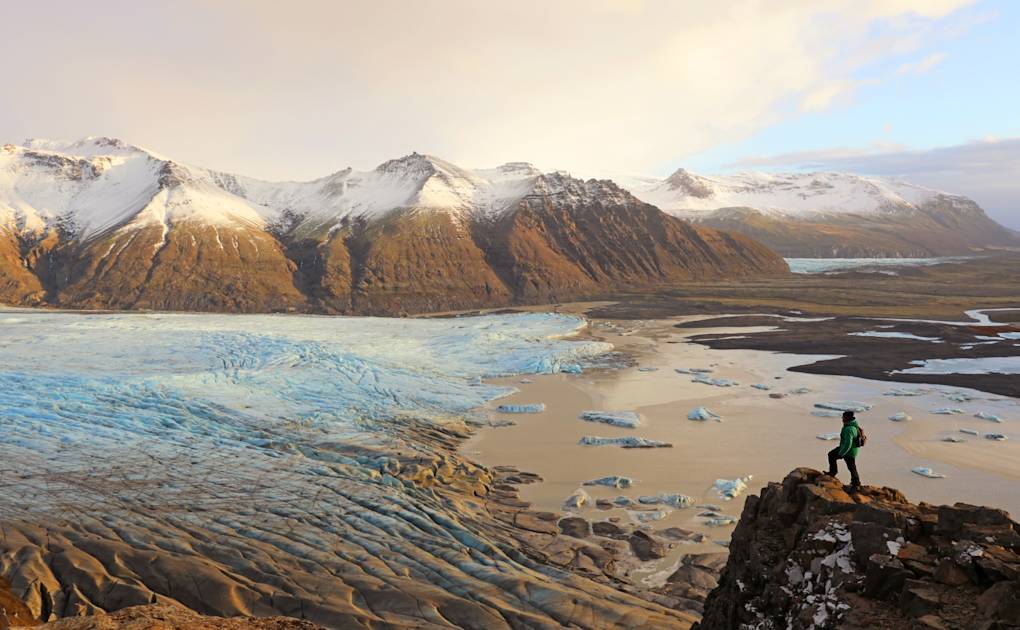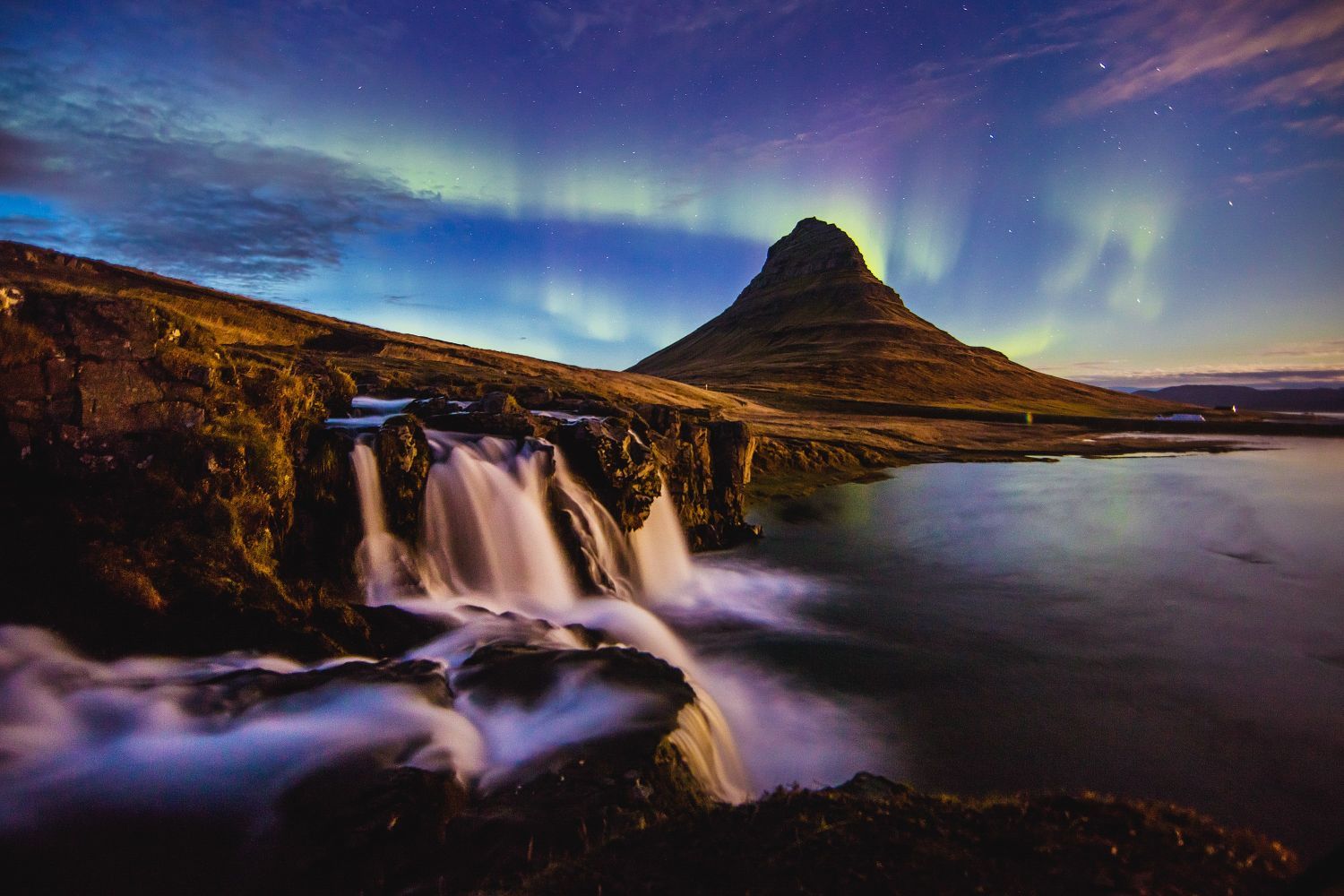Every winter, the dark skies above Iceland are illuminated by one of nature's most intriguing phenomena - the northern lights. Splashes of green, red and purple iridescence undulate across the skies; a beautiful sight that captivates anyone watching. According to Icelandic folklore, the northern lights are a result of the elves, or 'hidden people' (Huldufólk) dancing across the dark skies. These days, we know it's the result of charged particles colliding with the earth's atmosphere, but that doesn't make them any less intriguing.
Part of what makes seeing the northern lights so desirable is their elusivity - they aren't out there every day, for just anyone to see. In fact, they're normally only visible between mid-August to mid-April, on cloudless nights, when there's a good aurora forecast.
Curious about where and how to witness this awe-inspiring phenomenon? Here, we take a look at some of the best locations, times and techniques to experience the magic of the northern lights in Iceland.
Table of Contents
When to See the Northern Lights in Iceland

In Iceland, the best time to see the northern lights is between September and April, when the nights are long and dark. The best two months are September and March, especially around the equinoxes, when there is increased solar activity.
The reason you won't spot the northern lights in Iceland between late April and early August is because there's no darkness. Iceland is that far north. Every other time of year, you've got a chance.

Obviously there are no guarantees - if storms come in and cloud up the skies, then the lights will be covered and you won't see them. This does happen, for sure, even during high season. But for best results? Visit in those months. The optimal time to see the lights tends to be around 10pm-1am, though they can be visible in the dark anytime, and in winter in Iceland, it’s dark a lot of the time.
There's also a longer term solar cycle which runs over 11 years and dictates how strong the northern lights will be. During a solar maximum, there is increased solar activity and the earth's magnetic field becomes denser - this makes the aurora displays stronger, and more frequent. The next solar maximum is in 2024, which is an ideal time to go and see the northern lights in Iceland.
Where to See the Northern Lights in Iceland

The diversity in Iceland is simply incredible. This country has everything from glaciers to geothermal hot springs, ice caves to black sandy beaches and enormous waterfalls to world-beating long-distance treks. If you’re looking for the best places to spot the northern lights in Iceland, then you won’t have to work hard. Even in the capital, Reykjavík, you can sometimes see the northern lights.
Obviously, the further you can get away from light pollution, the better, and in Iceland that’s not hard to do
That said, there are some particularly good places to go in Iceland to see the northern lights. Obviously, the further you can get away from light pollution, the better, and in Iceland that’s not hard to do. Here are some of our top spots.
1. Laugarvatn

Laugarvatn is a hamlet of 200 people in the south of Iceland, just over an hour's drive from Reykjavik. It’s a real gateway hub for adventure in Iceland too, not far from Thingvellir National Park - a UNESCO protected site home to some of Iceland's most stunning scenery. Hiking out from accommodation at Laugarvatn can often provide a fantastic and accessible opportunity to see the aurora borealis.

Nearby is Landmannalaugar, home to thermal pools and a great lookout spot for the lights. It's also the start point for The Laugavegur Trail, which was recently included in National Geographic's '20 Best Hikes in the World'. It's a 55km hut to hut trek passing through mountains, gorges, glaciers and the Eyjafjallajökull volcano. Take it on in September, and you might be able to combine it with a sighting of the aurora.
2. Jökulsárlón

This glacial lagoon in the south of Iceland - five hours from Reykjavik - is often mentioned as one of the best places to see the northern lights. This is because the lights in the sky are reflected in the glacial waters, doubling the display. The adjacent black sand beach of Breiðamerkursandur is also a brilliant spot - the lights bounce off the icebergs on the sand, creating a unique kaleidoscopic affect.
3. Snæfellsnes National Park

Snaefellsnes Peninsula is about two hours' drive from Reykjavik, and home to Snæfellsjökull National Park. An astonishing diversity of landscapes is packed into this small peninsula - waterfalls, glaciers, rugged cliffs and Kirkjufell Mountain, said to be the most photographed mountain in the world. Why not see if you can grab a photo of the lights dancing behind it for the 'gram?
4. Vík


There are several reasons why this tiny coastal village in south Iceland is an ideal spot for aurora hunting. For a start, it's located in a dark sky area, far from urban light pollution. Secondly, it is positioned directly beneath the auroral oval, so frequently sees strong displays. Recommended spots to see the lights are Vík Church and Dyrhólaey cliffs. Vík is around two and a half hours' drive from Reykjavik.
5. Vatnajökull National Park


This vast nature reserve is an untrammelled wilderness of volcanoes, ravines, ice caves and the impressive Vatnajökull glacier. Open and unpopulated, it's a good spot to hunt for the aurora. A local guide will even be able to show you some designated camping spots along remote hiking trails - ideal viewing conditions.
Top Tips For Seeing the Northern Lights in Iceland

Check the Aurora Forecast
Before you head out into the cold, it's best to check the aurora forecast. Not only will it tell you the level of auroral activity (and the subsequent probability of seeing the northern lights) it will also tell you the cloud cover. The best time to see the northern lights is when there is low to no cloud cover and high auroral activity.
Download an Aurora Hunting App
One of the best apps for aurora hunters is My Aurora - it will send you notifications when activity is high, and give you a list of the best destinations near you to see the lights. Users can also upload photos of the northern lights for other users to see, which helps you discover good viewing locations too.
Be Patient
The northern lights reach their peak between 10pm and 2am, which is also when it's darkest. But that doesn't mean they'll be visible for four hours - they flicker in and out of visibility. What this means is that sometimes you'll be up quite late waiting for them. So make sure you wrap up warm!
Iceland: A Quick Fact File

Where is it? Iceland is a European island located midway between North America and mainland Europe. It’s up there in the Arctic Circle, which is what makes it so great for spotting the northern lights. It's between 64 and 66 degrees.
What’s the capital? Reykjavík is the capital city of Iceland, and the northernmost capital in the world. It’s also Iceland's largest city, home to 131,136 of the country's 356,991 population. The wider capital region, which includes Reykjavík is actually home to 233,034 of that count.
Currency? The currency of Iceland is the Icelandic króna.
Got an airport? Yes, sir. Keflavík Airport (KEF) is Iceland's largest international airport. There are also smaller airports - Ísafjörður, Egilsstaðir, Akureyri and the Reykjavík Domestic Airport.
Any good culture? You know it. There’s a literary heritage, and Iceland's literacy rate is among the highest in the world. Read 'Independent People' by Halldór Laxness, a social realist piece of Icelandic fiction from the 1930s which helped Laxness win the Nobel Prize for Literature some years later. More recently, 'The Blue Fox' by Icelandic writer Sjón is an enchanting read.
On the musical front, the music of Sigur Rós matches the serene yet dramatic scenery of the Icelandic backcountry, as does that of Much Better Adventures’ favourite and electronic artist Ólafur Arnalds. You might even see Bjork kicking about Reykjavík if you're lucky. Also, check out Dream Wife, an awesome all-female rock / riot grrrl band led by Icelandic vocalist Rakel Mjöll.
Oh, and by the way, Iceland is also rated the most gender-equal country in the world - something explored in Anne-Flore Marxer and Aline Bock's excellent snowboard and surf film 'A Land Shaped by Women'.
Related Content
- 10 of the Most Frequently Asked Questions About the Northern Lights
- Can You See the Northern Lights in Europe in Summer?
- Where are the Northern Lights? When and Where to See the Aurora Borealis
Inspired? Check out our Adventures in Iceland, and our other Northern Lights Holidays in Europe.
This article contains affiliate links. Which basically means we make a little commission if you click through and buy something. It doesn’t cost you anything, and it just means we can do more good things in good places.



